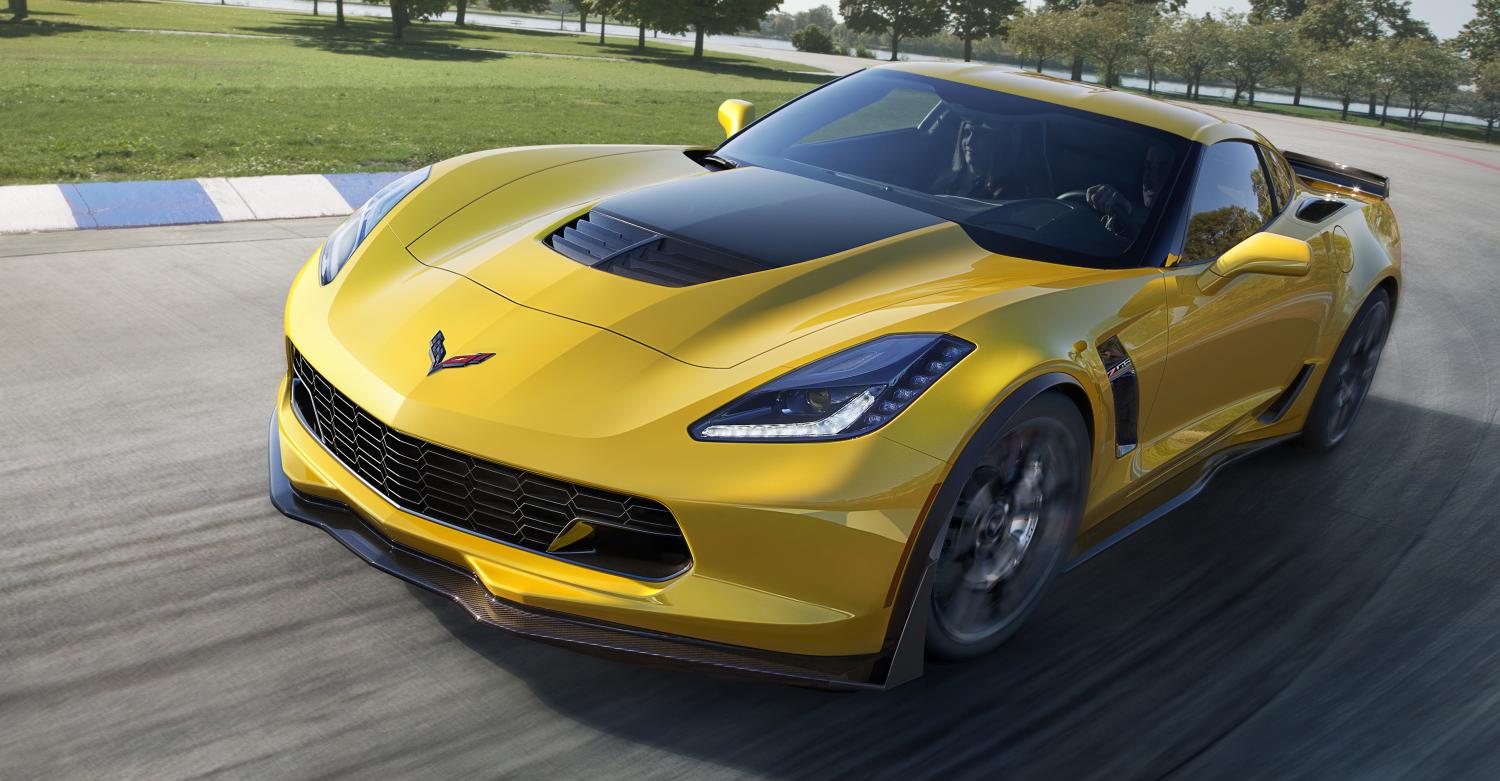
American supercar delivers unprecedented performance, technology
DETROIT – The 2015 Chevrolet Corvette Z06 – the most powerful and technologically advanced model in the iconic car’s 62-year history – will be offered at a suggested retail price of $78,995 while the convertible model will start at $83,995, Chevrolet announced today.
“The 2015 Corvette Z06’s performance and technical capabilities place it in the elite fraternity of supercars,” said Harlan Charles, Corvette product and marketing manager. “Very few cars in the world deliver 650 horsepower, true aerodynamic downforce, carbon fiber and performance technologies such as Magnetic Ride Control, Performance Traction Management and an electronic limited slip differential – and none gives the driver a transmission choice or the choice of a coupe with a removable roof panel or a full-power-top convertible.”
Leveraging learnings from the Corvette Racing program, the $2,995 Carbon Fiber Ground Effects package enables the Corvette Z06 to produce true aerodynamic downforce for increased stability at high speeds. The package adds a functional carbon fiber front splitter, carbon fiber rocker panels and a larger rear spoiler.
For the ultimate performance, the Z07 Performance Package is available for $7,995, adding Brembo carbon ceramic-matrix brake rotors that improve braking performance and contribute to better handling through reduced unsprung weight. The Z07 package adds adjustable front and rear aerodynamic components to the Carbon Fiber Ground Effects package for unprecedented aerodynamic downforce and Michelin Pilot Super Sport Cup tires for enhanced grip.
“The Z07 performance package enhances overall performance to make the Corvette Z06 one of the most track-capable cars you can buy off the dealership floor and still drive it to work every day,” said Charles.
Z06 models are offered in 1LZ, 2LZ and 3LZ trims. A range of available features enables customers to tailor the look and feel of their Z06, including:
- Premium Package with leather-wrapped interior
- Aero-enhancing carbon fiber ground effects package
- Performance Data Recorder and navigation
- Competition sport seats offered in leather or sueded microfiber
- Carbon fiber interior trim and carbon fiber convertible tonneau cover inserts
- Visible carbon fiber roof panel (Coupe)
- Tintcoat exterior colors, several available wheel finishes and several available brake caliper colors.
Most powerful, technologically advanced Corvette ever
The Z06 rejoins the Corvette lineup for 2015 with a stronger aluminum frame than previous models, an aero package designed to produce performance-enhancing downforce and an all-new, supercharged 6.2L V-8 engine rated at an SAE-certified at 650 horsepower (485 kW) and 650 lb-ft of torque (881 Nm). That makes it the most powerful production car ever from General Motors and one of the most powerful production cars available in the United States.
To balance performance and efficiency, the LT4 leverages the same trio of advanced technologies introduced on the Corvette Stingray – direct injection, Active Fuel Management (cylinder deactivation) and continuously variable valve timing – and leverages them with a new, more efficient supercharger. Combined with the fuel-efficient multi-speed transmissions, aerodynamic design and lightweight construction, they help make the new Z06 surprisingly efficient.
The Corvette Z06 also leverages other technologies introduced on the Corvette Stingray, including the strategic use of lightweight materials and advanced driver technologies, with calibrations tailored for its capabilities. The aluminum frame structure, for example, is 20 percent stiffer than the previous, fixed-roof Z06.
Additional technologies support the car’s tremendous performance capabilities and enhance the driving experience, including:
- Third-generation Magnetic Selective Ride Control dampers are standard and can be adjusted for touring comfort or maximum track performance via the standard Driver Mode Selector
- Performance Traction Management is available in the Track mode of the Drive Mode Selector and offers five settings of torque reduction and brake intervention for track driving
- Launch control is available in Track mode for manual and automatic transmissions, providing maximum off-the-line acceleration
- An electronic limited-slip differential, also standard equipment on Z06, adjusts the rate at which the limited slip engages, to balance between steering response and stability in different driving conditions with more aggressive performance in Sport and Track modes.
The Z06 offers three increasing levels of aerodynamic downforce:
- The standard Z06 features a front splitter, spats around the front wheel openings, a unique carbon-fiber hood with a larger vent, and an aggressive rear spoiler.
- The available carbon-fiber aero package – in either carbon flash paint or a visible carbon-fiber finish – adds a carbon-fiber front splitter with aviation-style winglets, carbon fiber rocker panels, and a larger rear spoiler with a fixed wickerbill, which combine to create true aerodynamic downforce
- The available Z07 package adds larger winglets to the front splitter, along with an adjustable, see-through center section on the rear spoiler for track use. With this package, the Corvette Z06 delivers the most aerodynamic downforce of any production car GM has tested.
Drivers can monitor the Z06’s performance without taking their eyes off the road via a standard color head-up display that, among the range of performance readouts, displays a g-meter in Track mode.
The Z06 also offers the award-winning, industry-first Performance Data Recorder – or PDR – which enables users to record high-definition video, with telemetry overlays, of their driving experiences on and off the track. The racing-derived system is included with the available navigation system.
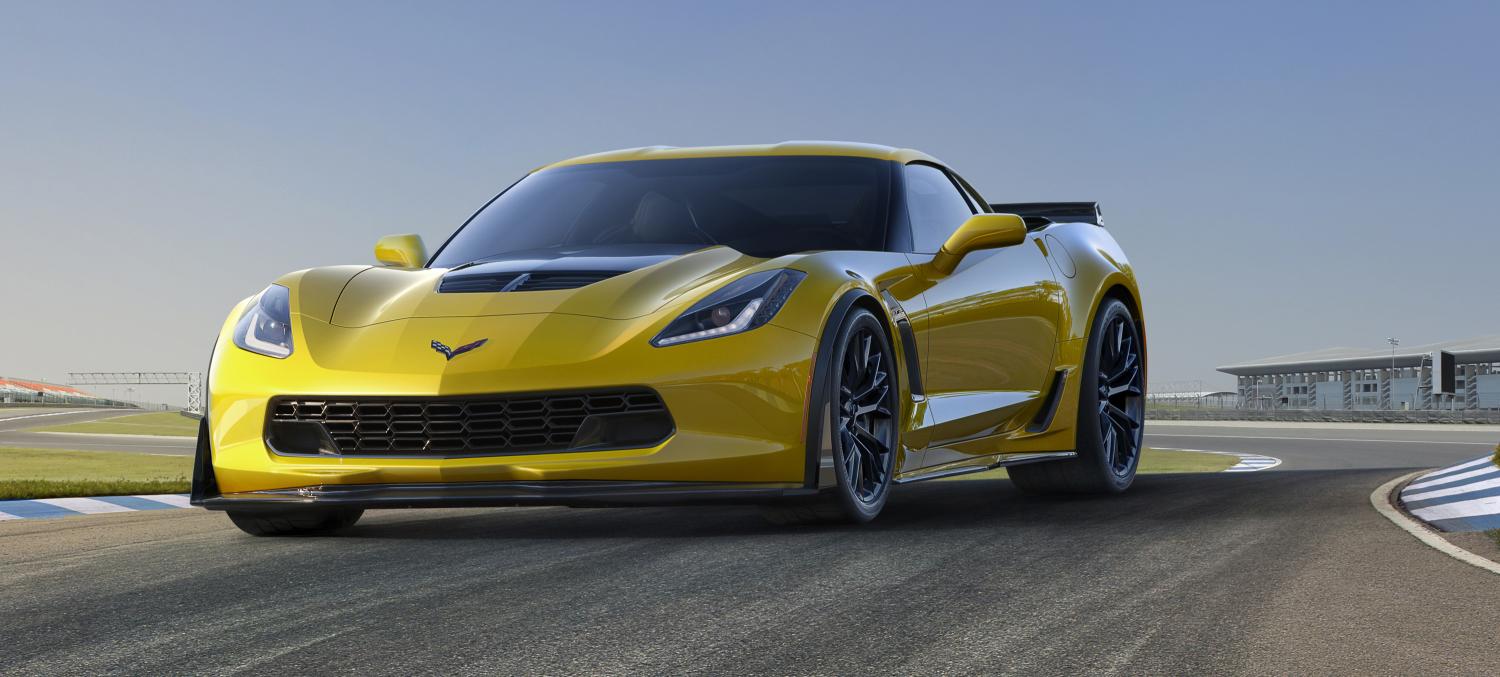
- Enters supercar territory with race-proven design, advanced technologies and world-class performance
- With track-focused Z07 performance package, 2015 Corvette Z06 delivers faster lap times than 2013 Corvette ZR1
- First Corvette Z06 to offer supercharged engine, removable roof panel and available paddle-shift automatic transmission
DETROIT – Chevrolet today introduced the most track-capable Corvette in the brand’s history – the 2015 Corvette Z06. It stretches the performance envelope for Corvette with unprecedented levels of aerodynamic downforce, at least 625 horsepower from an all-new supercharged engine, and an all-new, high-performance eight-speed automatic transmission – all building on the advanced driver technologies introduced on the Corvette Stingray.
“The new Z06 delivers levels of performance, technology and design that rival the most exotic supercars in the world,” said Mark Reuss, president, General Motors North America. “And the Z06 leverages the engineering expertise of GM, offering the choice of two world-class transmissions, supercar performance without supercar fuel consumption and technologies that make it easier to fully enjoy the incredible experience of driving it.”
The 2015 model is the first Corvette Z06 to offer a supercharged engine, an automatic transmission and, thanks to a stronger aluminum frame, a removable roof panel. The new, supercharged 6.2L engine is expected to deliver at least 625 horsepower (466 kW), and can be matched with either a seven-speed manual or an all-new, high-performance eight-speed automatic transmission with paddle shifters for manual control. The aluminum frame carries over from the Corvette Stingray and will be used essentially unchanged for the Corvette Racing C7.R.
A track-focused Z07 Performance Package adds unique components for true aerodynamic downforce, Michelin Pilot Super Sport Cup tires for enhanced grip, and Brembo carbon ceramic-matrix brake rotors that improve braking performance and contribute to greater handling through reduced unsprung weight. Although development testing is ongoing, the Z07 package has already recorded some of the fastest lap times ever for a Corvette, surpassing even the ZR1.
“The Corvette Z06 is a great example of the technology transfer between racing and production Corvettes,” said Tadge Juechter, Corvette chief engineer. “First, we took what we learned on the Corvette Racing C6.R and applied that to the all-new Corvette Stingray. Then, using the Stingray as a foundation, the Z06 and C7.R were developed to push the envelope of performance on the street and the track.”
Supercharged, efficient performance
The heart of the 2015 Corvette Z06 is the all-new LT4 6.2L supercharged V-8 engine, expected to deliver an estimated 625 horsepower (466 kW) and 635 lb-ft of torque (861 Nm). To balance performance and efficiency, the LT4 leverages the same trio of advanced technologies introduced on the Corvette Stingray: Direct injection, Active Fuel Management, or cylinder deactivation, and continuously variable valve timing.
These technologies – combined with the fuel-efficient multi-speed transmissions, aerodynamic design and lightweight construction – help make the new Z06 surprisingly fuel efficient.
“The supercharged LT4 engine delivers the greatest balance of performance and efficiency ever in the Corvette,” said John Rydzewski, assistant chief engineer for Small-Block engines. “It is one of the world’s only supercharged engines to incorporate cylinder deactivation technology, enabling it to cruise efficiently on the highway with reduced fuel consumption, but offer more than 600 horsepower whenever the driver calls up its tremendous power reserve.”
To maintain the Z06’s mass and performance targets, the LT4 engine was designed with a more-efficient, more-compact supercharger. Even with its integrated supercharger/intercooler assembly mounted in the valley between the cylinder heads, the engine is only about one inch (25 mm) taller than the Corvette Stingray’s LT1 engine – while delivering nearly 37 percent more horsepower and 40 percent more torque.
The new 1.7L Eaton R1740 TVS supercharger spins at up to 20,000 rpm – 5,000 rpm more than the supercharger on the Corvette ZR1’s LS9. The rotors are shorter in length, too, which contributes to their higher-rpm capability – and enables them to get up to speed quicker, producing power-enhancing boost earlier in the rpm band. That boost is achieved more efficiently, thanks to a new, more direct discharge port that creates less turbulence, reducing heat and speeding airflow into the engine.
The LT4 engine also has several unique features designed to support its higher output and the greater cylinder pressures created by forced induction, including:
- Rotocast A356T6 aluminum cylinder heads that are stronger and handle heat better than conventional heads
- Lightweight titanium intake valves and machined connecting rods for reduced reciprocating mass
- High 10.0:1 compression ratio – for a forced-induction engine – enhances performance and efficiency and is enabled by direct injection
- Forged aluminum pistons with unique, stronger structure to ensure strength under high cylinder pressures
- Stainless steel exhaust headers and an aluminum balancer that are lighter than their LT1 counterparts
- Standard dry-sump oiling system with larger cooler capacity than Z51; used with dual-pressure-control oil pump.
The LT4 will be built in Tonawanda, N.Y., and at the new Performance Build Center in Bowling Green, Ky.
Eight speeds, no waiting
The supercharged LT4 is offered with a standard seven-speed manual transmission with Active Rev Match, or an all-new 8L90 eight-speed paddle-shift automatic transmission designed to enhance both performance and efficiency.
“Unlike most ultra-performance cars, the Corvette Z06 offers customers the choice between two transmissions to suit their driving styles,” said Juechter. “The seven-speed gives the driver the control of a true three-pedal manual transmission with perfect shifts enabled by Active Rev Matching. The new eight-speed automatic offers drivers the comfort and drivability of a true automatic transmission, as well as lightning-fast shifts and manual control for track driving.”
The seven-speed manual incorporates rev-matching technology for upshifts and downshifts. This driver-selectable feature can be easily engaged or disengaged via paddles on the steering wheel. The seven-speed is used with a new dual-mass flywheel and dual-disc clutch, which deliver greater shift quality and feel through lower inertia.
The eight-speed automatic is tuned for world-class shift-response times, and smaller steps between gears keep the LT4 within the sweet spot of the rpm band, making the most of the output of the supercharged engine for exhilarating performance and greater efficiency.
For performance driving, the transmission offers full manual control via steering wheel paddles, and unique algorithms to deliver shift performance that rivals the dual-clutch/semi-automatic transmissions found in many supercars – but with the smoothness and refinement that comes with a conventional automatic fitted with a torque converter.
In fact, the 8L90’s controller analyzes and executes commands 160 times per second, and wide-open throttle upshifts are executed up to eight-hundredths of a second quicker than those of the dual-clutch transmission offered in the Porsche 911.
“There’s no trade-off in drivability with the new 8L90 eight-speed automatic transmission – it was designed to deliver performance on par with dual-clutch designs, but without sacrificing refinement,” said Bill Goodrich, assistant chief engineer for eight-speed automatic transmissions. “It is also the highest-capacity automatic transmission ever offered in a Chevrolet car.”
Featuring four gearsets and five clutches, creative packaging enables the GM-developed eight-speed automatic to fit the same space as the six-speed automatic used in the Corvette Stingray. Extensive use of aluminum and magnesium make it more than eight pounds (4 kg) lighter than the six-speed. Along with design features that reduce friction, the 8L90 is expected to contribute up to 5-percent greater efficiency, when compared with a six-speed automatic.
The eight-speed automatic will be built at GM’s Toledo, Ohio, transmission facility.
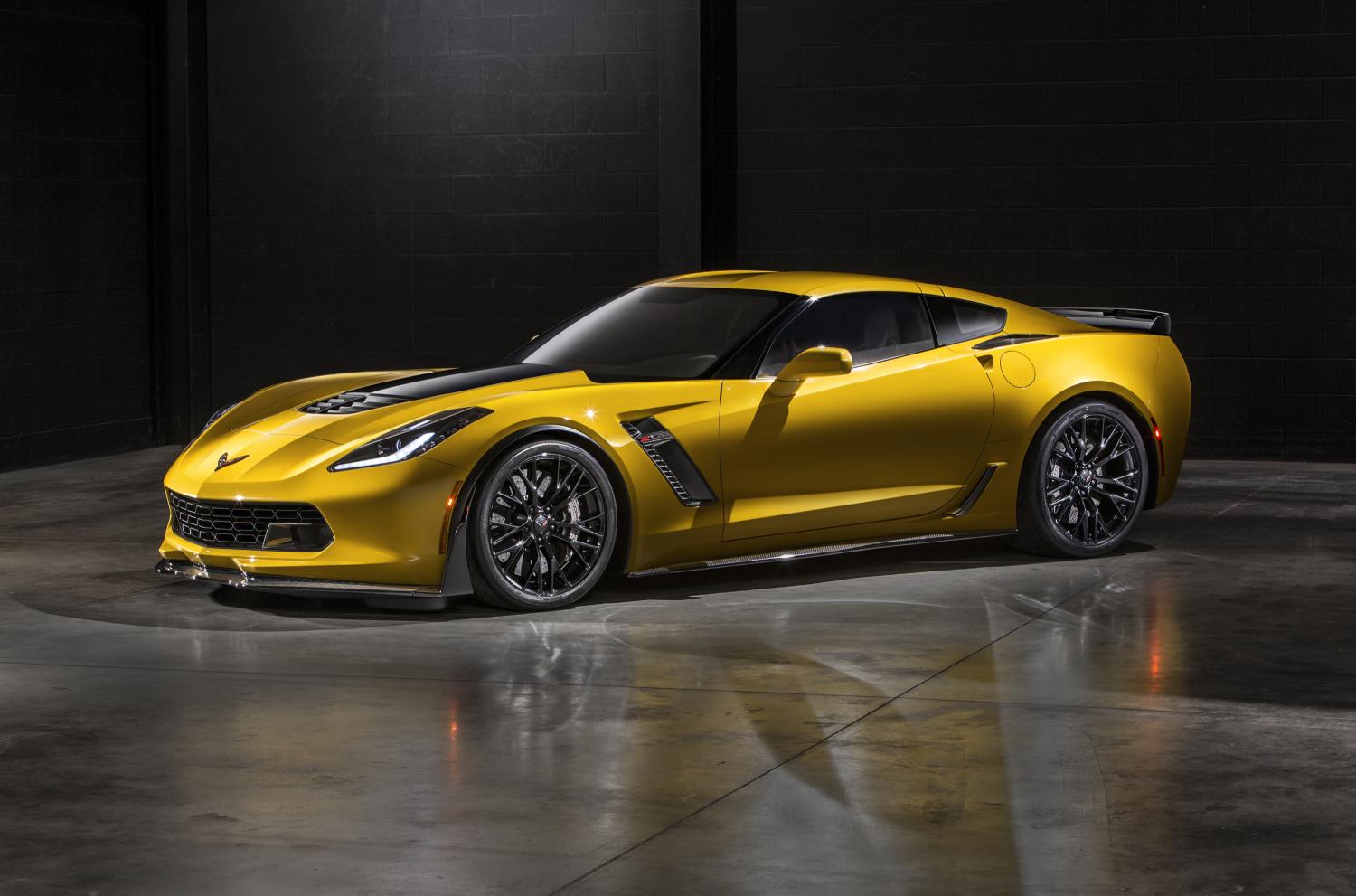

Designed for downforce
The performance targets of the Z06 also posed a challenge for the design team, which had to create a striking design that also contributed to increased capabilities.
“Practically every exterior change served a functional purpose, as this beast needed more of everything,” said Tom Peters, Corvette design director, “The flared fenders accommodate larger, wider wheels and tires for more grip. The larger vents provide more cooling air to the engine, brakes, transmission and differential for increased track capability. The more aggressive aerodynamic package generates true downforce for more cornering grip and high-speed stability.”
The design changes began not with the exterior panels, but the tires.
To deliver the levels of grip needed for the Z06’s performance targets, the Z06 was fitted with larger Michelin tires (Pilot Super Sport tires for the Z06; Sport Cup 2 tires with the Z07 package). The P285/30ZR19 front tires are 1.5 inches wider than the tires on the Stingray, while the 335/25ZR20 rear tires are two inches wider.
To cover the wider tire tread, the fenders of the Z06 were extended by 2.2 inches (56 mm) at the front, and 3.15 inches (80 mm) at the rear. These extensions give the Corvette Z06 a wider, lower appearance further emphasized by a unique rear fascia. It incorporates the same taillamp assemblies as the Stingray, but on the Z06 the taillamps are pushed approximately three inches farther apart, toward to edges of the body.
The tires are mounted on lightweight, spin-cast aluminum wheels that are also wider than the Stingray (19 x 10 inches in front and 20 x 12 inches in the rear). Their open, ultralight design showcases the massive Brembo brakes, which are part of the design aesthetic:
- The Z06 features two-piece steel rotors, measuring 14.6 x 1.3-inch (371 x 33 mm) front and 14.4 x 1-inch (365 x 25 mm) rear, with aluminum six-piston and four-piston fixed calipers, respectively
- The Z07 package adds larger, 15.5 x 1.4-inch (394 x 36 mm) front and 15.3 x 1.3-inch (388 x 33 mm) carbon ceramic-matrix brake rotors for consistent performance lap after lap, and collectively save 23 pounds over the standard Z06 rotors.
To harness the cornering and braking grip afforded by the larger tires and brakes, the exterior of the Corvette Z06 is tailored to produce aerodynamic downforce that presses the tires to the ground at high speeds.
The Z06 will offer three, increasing levels of aerodynamic downforce:
- The standard Z06 features a front splitter, spats around the front wheel openings, a unique carbon-fiber hood with a larger vent, and the rear spoiler from the Corvette Stingray’s Z51 Performance Package
- An available carbon-fiber aero package – in either black or a visible carbon-fiber finish – adds a carbon fiber front splitter with aviation-style winglets, carbon fiber rocker panels, and a larger rear spoiler with a fixed wickerbill – a small, vertical tab at the edge of the spoiler that significantly increases downforce
- The available Z07 package add larger winglets to the front splitter, along with an adjustable, see-through center section on the rear spoiler for track use. With this package, the Corvette Z06 delivers the most aerodynamic downforce of any production car that GM has tested.
The exterior design also reflects the increased cooling required for the new Corvette Z06. For example, the mesh pattern on the front fascia was painstakingly designed to deliver the most possible airflow to the supercharger’s intercooler heat exchanger, so much that the mesh grill directs more air into the engine bay than if the grille was removed.
The unique grille also features dedicated brake-cooling intakes and wider grille outlets on the bottom serve as air diffusers. The grille is complemented with a larger hood vent, which vents hot air from the engine compartment and contributes to downforce by allowing air driven through the grille to exit through the hood rather than being forced under the car, which could create lift.
Additional cooling elements include larger front fender vents and unique air blades over the inlets on the rear fenders, which force about 50 percent more air into the cooling ducts for the transmission and differential coolers than those on the Stingray. To cope with the additional airflow, the Z06 has also has larger rear-fascia openings than the Stingray.
Standard front and rear brake-cooling ducts, including Z06-signature rear ducts integrated in front of the rear fender openings, are also part of the functional design changes.
Inside, the Corvette Z06 is distinguished from the Corvette Stingray by unique color schemes that emphasize the driver-focused cockpit, and a unique, flat-bottomed steering wheel.
Like the Stingray, the Z06 will be offered with two seating choices: a GT seat, for all-around comfort, and a Competition Sport seat with more aggressive side bolstering, which provides greater support on the track. The frame structure for both seats is made of magnesium, for greater strength and less weight than comparable steel frames. They’re also more rigid, contributing to the enhanced feeling of support during performance driving.
The Z06 also benefits from interior details designed for high-performance driving, first introduced on the Stingray, including a steel-reinforced grab bar on the center console for the passenger and soft-touch materials on the edge of the console, where the driver naturally braces during high-load cornering.
The performance-supporting elements inside the new Corvette Z06 are complemented by unprecedented attention to detail and build quality. All models feature a fully wrapped interior, where every surface is covered with premium, soft-touch materials. Available materials, depending on the trim level, include Napa leather, aluminum, carbon fiber and micro-suede.

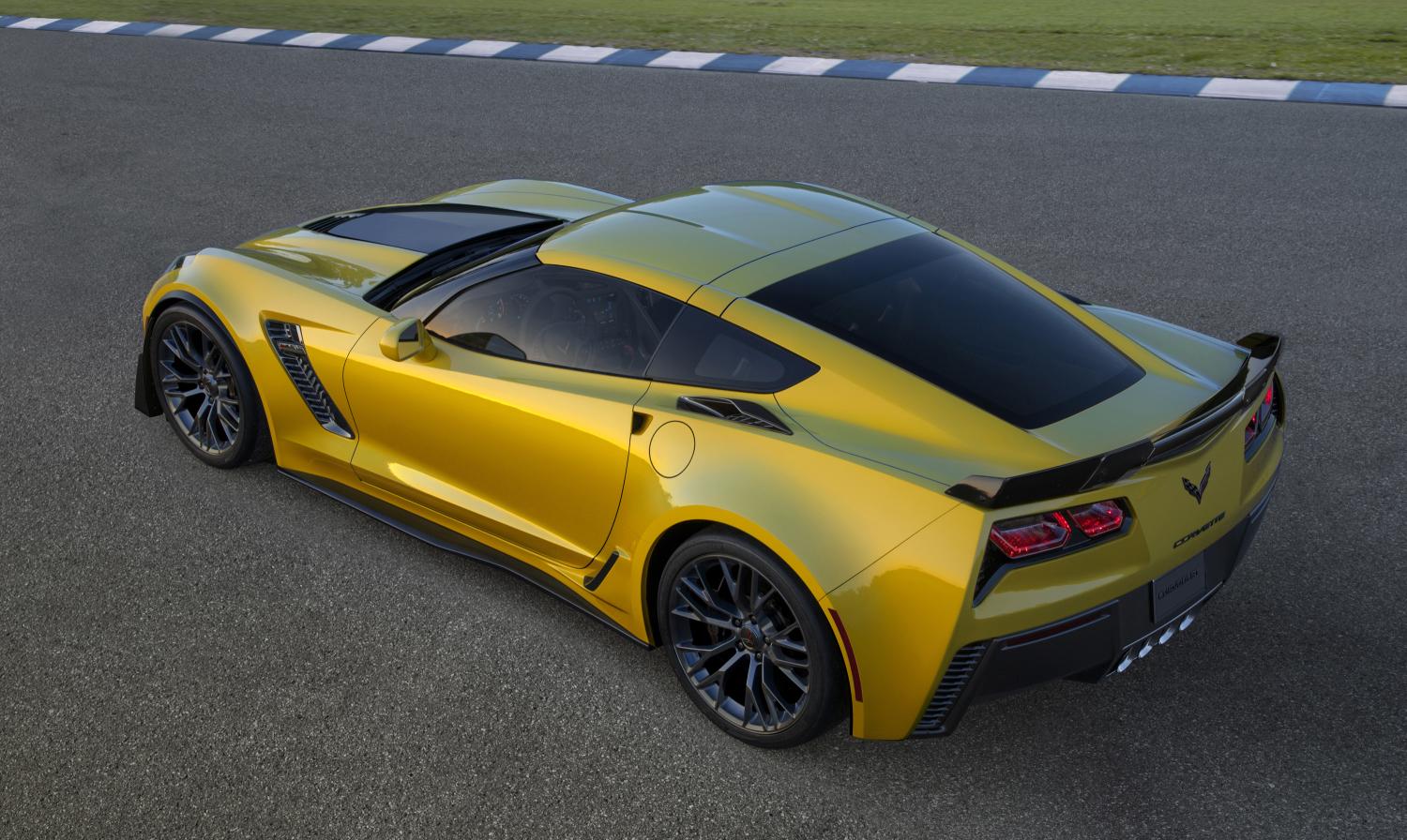

Track-proven technologies
The 2015 Corvette Z06 leverages the technologies introduced on the Corvette Stingray, including the strategic use of lightweight materials and advanced driver technologies, with unique features and calibrations tailored for its capabilities.
“Our mission with the seventh-generation Corvette was to make the performance levels more accessible, enabling drivers to exploit every pound-foot of torque, every “g” of grip and every pound of downforce,” said Juechter. “It’s a philosophy we introduced with the 460-horsepower Corvette Stingray – and one that’s even more relevant with an estimated 625 horsepower at your beck and call.”
For the first time ever, the Corvette Z06’s aluminum frame will be produced in-house at General Motors’ Bowling Green assembly plant. It’s the same robust, lightweight frame used on the Corvette Stingray and it will be used essentially unchanged for the C7.R race cars.
The stiffer design of the aluminum frame allows the Corvette Z06 to be offered with a removable roof panel for the first time. With the lightweight, carbon fiber roof panel removed, the new Corvette Z06 offers 20 percent more structural rigidity than the previous model’s fixed-roof design. It is 60 percent stiffer than the previous model with the roof panel installed.
The new Z06 retains the SLA-type front and rear suspension design of the Corvette Stingray but uniquely calibrated for the higher performance threshold. The third-generation Magnetic Selective Ride Control dampers are standard on Z06. They can be adjusted for touring comfort or maximum track performance via the standard Driver Mode Selector.
Like the Stingray, the Driver Mode Selector tailors up to a dozen features of the Z06 to suit the driver’s environment, including:
- Launch control: Available in Track mode for manual and automatic transmissions, providing maximum off-the-line acceleration
- Active handling (StabiliTrak electronic stability control): A “competitive” setting is available in Track mode and is more suited for on-track conditions. It can also be disabled, giving the driver complete control
- Traction control: Weather mode tailors traction control and engine torque for driving in inclement conditions
- Performance Traction Management: Available in Track mode and offers five settings of torque reduction and brake intervention for track driving
- Electronic Limited Slip Differential: Adjusts the rate at which the limited slip engages, to balance between steering response and stability in different driving conditions with more aggressive performance in Sport and Track modes.
The smart electronic limited-slip differential, or eLSD, is standard on the Z06 to make the most of the torque split between the rear wheels. The system features a hydraulically actuated clutch that can infinitely vary clutch engagement and can respond from open to full engagement in tenths of a second. It shifts torque based on a unique algorithm that factors in vehicle speed, steering input and throttle position to improve steering feel, handling balance and traction.
The eLSD is fully integrated with Electronic Stability Control and Performance Traction Management systems. Its calibrations vary among three modes, based on the Drive Mode Selector setting:
- Mode 1 is the default setting for normal driving and emphasizes vehicle stability
- Mode 2 is engaged when electronic stability control is turned off in the Sport or Track modes. This calibration enables more nimble turn-in and traction while accelerating out of a corner
- Mode 3 is automatically selected when Performance Traction Management is engaged. This calibration has the same function as Mode 2, but is fine-tuned to work with Performance Traction Management.
The new Corvette Z06 will be available in early 2015. Performance data and pricing will be announced closer to the start of production.

CORVETTE Z06 SPRINTS TO 60 MPH IN LESS THAN 3 SECONDS
New eight-speed automatic enables 2.95-sec. 0-60 time, 10.95-sec. quarter-mile
DETROIT – The performance of the all-new, 2015 Chevrolet Corvette Z06 establishes it as one of the most capable vehicles on the market – and one of the few to achieve sub-3-second 0-60 performance and a sub-11-second quarter-mile time.
“The Corvette has long been known as America’s sports car,” said Mark Reuss, General Motors’ executive vice president, Global Product Development. “With the capability of the new Z06 rivaling the best performance cars in the world, we will also be America’s Supercar.”
The Corvette Z06 accelerates from a rest to 60 mph in only 2.95 seconds when equipped with the all-new, available eight-speed paddle-shift automatic transmission – and achieves it in 3.2 seconds with the standard seven-speed manual transmission.
A quarter-mile sprint takes just 10.95 seconds with the eight-speed automatic and 11.2 seconds with the seven-speed manual. With both versions, the Corvette Z06 hits 127 mph at the end of the quarter-mile.
When it comes to braking performance, the Z06 can stop from 60 mph in only 99.6 feet. That’s the best braking performance of any production car GM has ever tested. Additionally, the Corvette Z06 achieves 1.2 g in lateral acceleration compared with the Corvette’s previous best 1.13 g.
The new Z06 is also the fastest production car ever tested at GM’s 2.9-mile Milford Road Course, beating the record set by the Corvette ZR1 by a full second.
All test results were achieved with Z06 coupes fitted with the Z07 Performance package, which adds Brembo carbon ceramic brake rotors and Michelin Pilot Sport Cup 2 tires. The Z07 package also features the most aggressive aerodynamic package available on the Corvette Z06, which delivers the most downforce of any production car GM has ever tested.
“The defining aspect of driving the Z06 is seamless integration of power, technology and aerodynamics,” said Tadge Juechter, Corvette chief engineer. “As a result, the Z06 delivers ferocious acceleration, tenacious handling, and high-speed stability that few cars can match.”
It is the first Corvette Z06 with a supercharged engine – SAE certified at 650 horsepower and 650 lb-ft of torque – and the first with an available eight-speed paddle-shift automatic transmission. Performance-enhancing Magnetic Ride Control and Performance Traction Management are standard, and the award-winning, industry-first Performance Data Recorder is available.
The 2015 Corvette Z06 coupe goes on sale in in early 2015 priced at $78,995, while the Z06 convertible goes on sale in the second quarter, priced at $83,995.
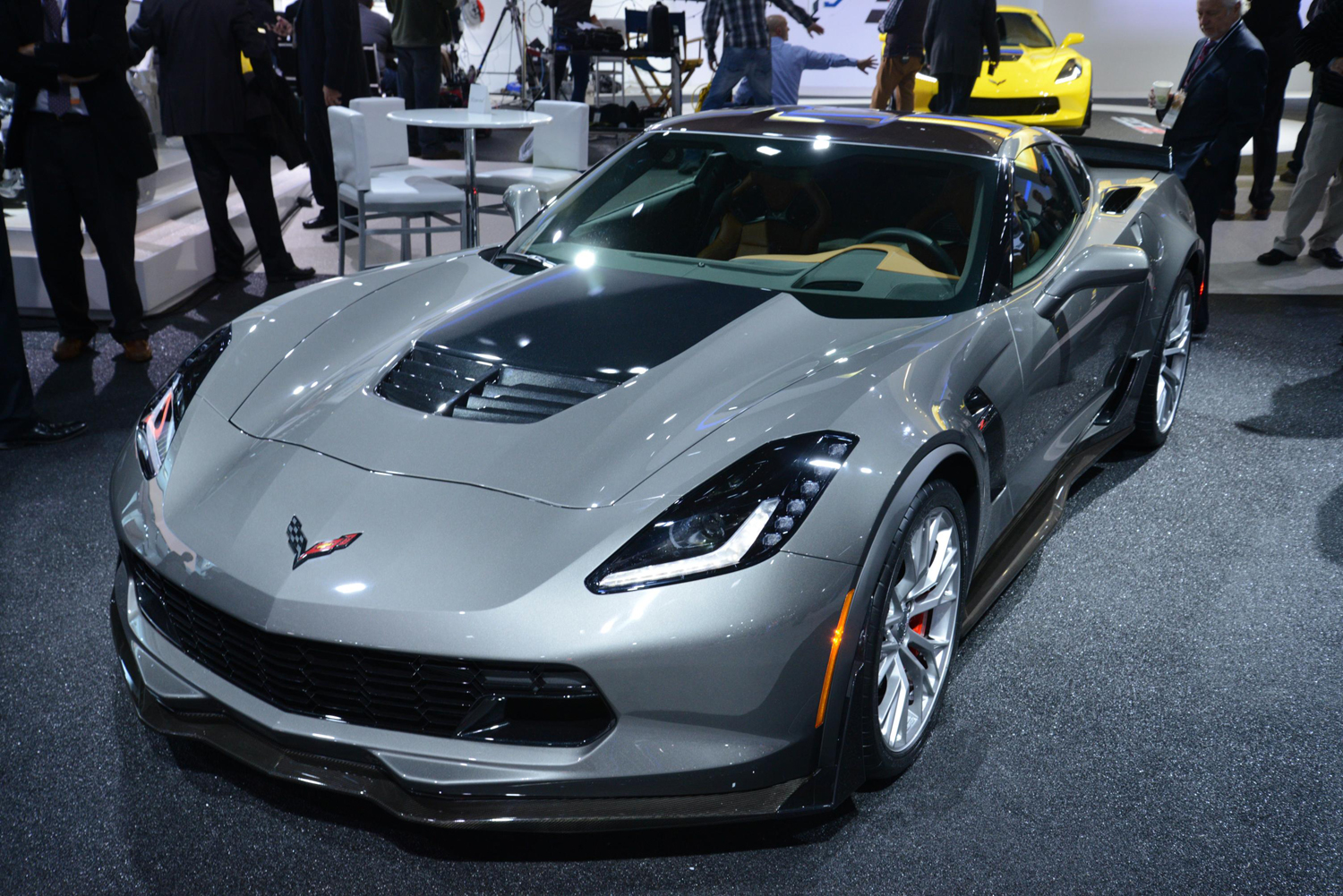



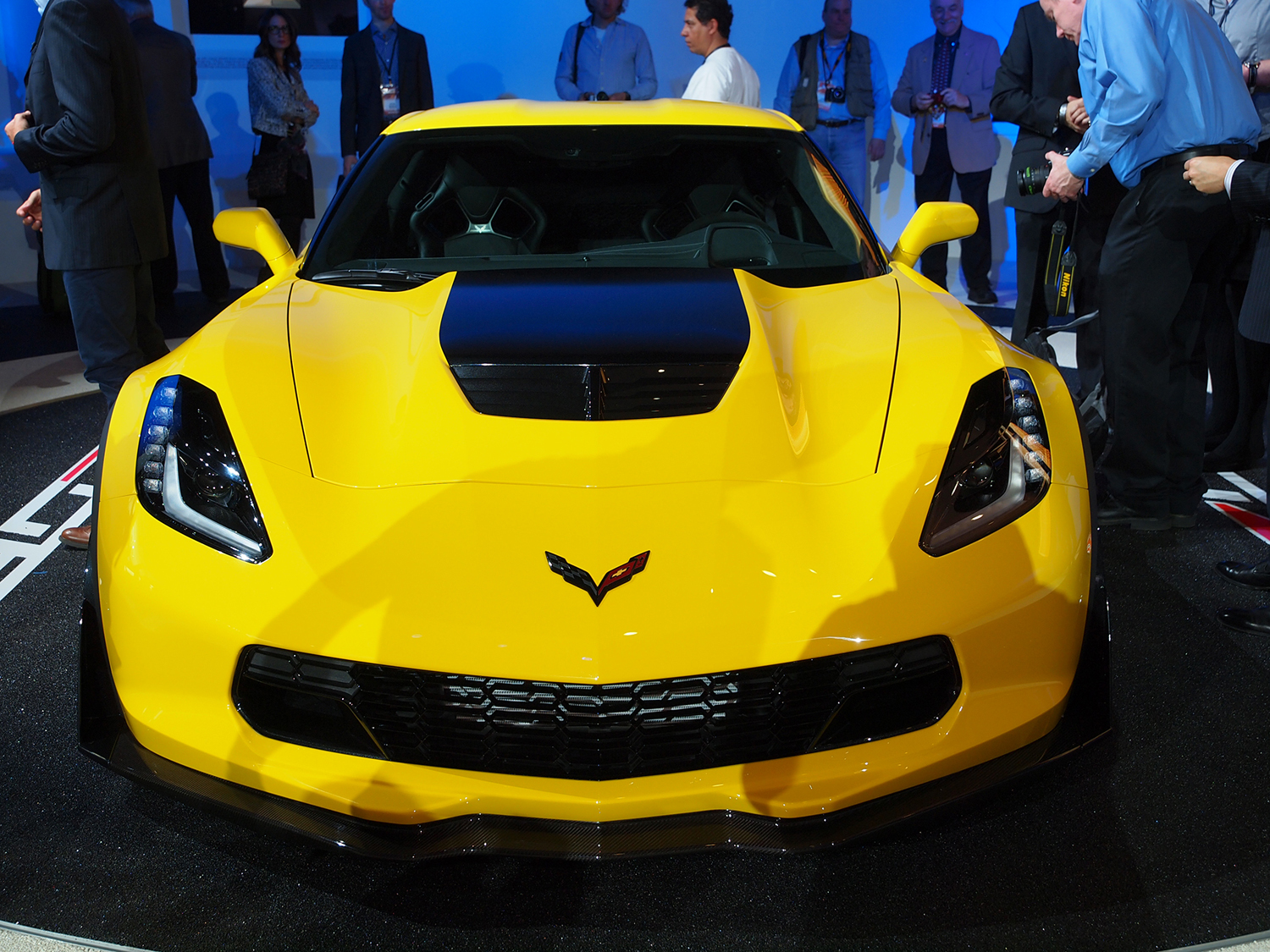
2015 CORVETTE Z06 RATED AT 650 HORSEPOWER
Supercharged LT4 V-8 engine is the most powerful ever from Chevrolet
DETROIT – The all-new 2015 Corvette Z06 is the most powerful production car ever from General Motors and one of a few production cars available in the United States that delivers more than 600 horsepower.
The Z06’s LT4 supercharged 6.2L V-8 engine is SAE-certified at 650 horsepower (485 kW) at 6,400 rpm and 650 lb-ft of torque (881 Nm) at 3,600 rpm.
“The LT4 Small Block sets a new benchmark for power and torque at GM,” said Steve Kiefer, vice president, GM Powertrain Engineering. “The engine also puts the new Corvette Z06 on par with the most powerful supercars offered in America, while delivering performance with impeccable manners that make it suitable for daily driving.”
Compared with other supercar engines, the LT4 is a veritable fountain of low-end torque, producing 457 lb-ft (619 Nm) just off idle and 625 lb-ft (847 Nm) by only 2,800 rpm. The V-12-powered Ferrari F12 Berlinetta, for example, produces about 28 percent less torque than the Z06, despite offering about 12 percent more horsepower – and its peak torque isn’t achieved until 6,000 rpm. The LT4 maintains 90 percent of its peak torque, or 592 lb-ft (802 Nm), from 2,500 to 5,400 rpm.
The new LT4 engine eclipses the Porsche 911 Turbo S engine’s peak power levels by 90 horsepower (67 kW) and 134 lb-ft of torque (182 Nm).
“Torque is the pulling power of an engine and the LT4’s abundance of it at every rpm in the engine’s speed range helps the 2015 Corvette Z06 accelerate quicker and respond nearly instantaneously,” said Jordan Lee, chief engineer for Small Block engines. “It’s the very definition of power on demand.”
The new Z06 engine produces 40 percent more peak torque (180 lb-ft / 244 Nm) than the previous-generation’s 7.0L LS7 engine – and 7.5 percent more than the supercharged 2013 Corvette ZR1’s 604 lb-ft (819 Nm). At 3,200 rpm, the new LT4 surpasses the LS7 by 208 lb-ft of torque (252 Nm). On the horsepower side of the graph, the LT4’s 650-hp rating is 29 percent greater than the LS7’s 505 horsepower (376 kW), and 12 horses more than the ZR1’s LS9 engine.
“The new LT4 engine builds on the design strengths of our previous supercharged engine and leverages the technologies introduced on the Corvette Stingray – direct injection, cylinder deactivation and continuously variable valve timing – to take Corvette performance to an all-new plateau,” said Lee. “Our new, very compact supercharger also helps the engine make power more quickly, and perhaps more importantly, it helps produce more torque earlier in the rpm band.”
“It’s also worth mentioning that the LT4’s supercar performance numbers are achieved with an engine that is nearly the same size as the very compact LT1 engine introduced in the 2014 Corvette Stingray,” Lee said. “The power density of the LT4 makes it one of the smallest and lightest 650-hp engines in the industry.”
LT4 details
The new LT4 engine is based on the same Gen 5 small block foundation as the Corvette Stingray’s LT1 6.2L naturally aspirated engine, incorporating several unique features designed to support its higher output and the greater cylinder pressures created by forced induction, including:
- Rotocast A356T6 aluminum cylinder heads that are stronger and handle heat better than conventional aluminum heads
- Lightweight titanium intake valves
- Machined, forged powder metal steel connecting rods for reduced reciprocating mass
- High 10.0:1 compression ratio – for a forced-induction engine – enhances performance and efficiency and is enabled by direct injection
- Forged aluminum pistons with unique, stronger structure to ensure strength under high cylinder pressures
- Stainless steel exhaust manifolds and an aluminum balancer that are lighter than their LT1 counterparts
- Standard dry-sump oiling system with a dual-pressure-control oil pump.
A new 1.7L supercharger spins at up to 20,000 rpm – 5,000 rpm more than the supercharger on the Corvette ZR1’s engine. The rotors are smaller in diameter, which contributes to their higher-rpm capability – and enables them to produce power-enhancing boost earlier in the rpm band. That boost is achieved more efficiently via a more direct discharge port that creates less turbulence, reducing heat and speeding airflow into the engine.
“The Small Block’s cam-in-block design heritage has always enabled very high performance and responsiveness in a small, compact package – an attribute amplified by the performance of our new supercharger’s design,” said Lee.
The LT4 is assembled at the new Performance Build Center at GM’s Bowling Green Assembly Plant and at GM’s Tonawanda engine plant in New York. It is matched with a standard seven-speed manual transmission or an all-new, paddle-shift eight-speed automatic transmission built in Toledo, Ohio.
Designed to deliver shift responses on par with the world’s best dual-clutch transmissions, it is the first automatic offered in a Z06. It also makes the Z06 one of the few cars this powerful to offer the choice of a conventional manual transmission or an eight-speed automatic.
The 2015 Corvette Z06 goes on sale in the fourth quarter of 2014.
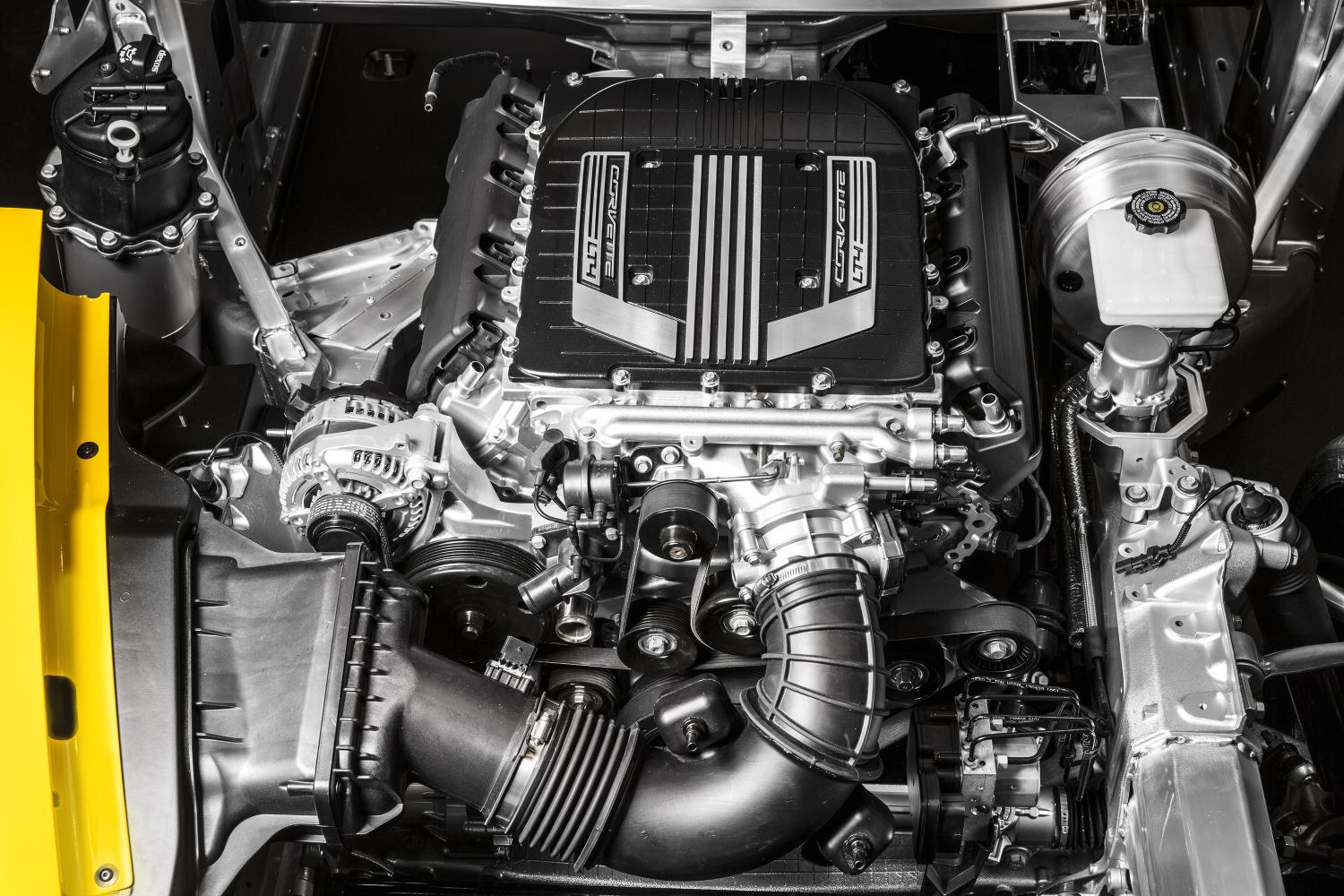
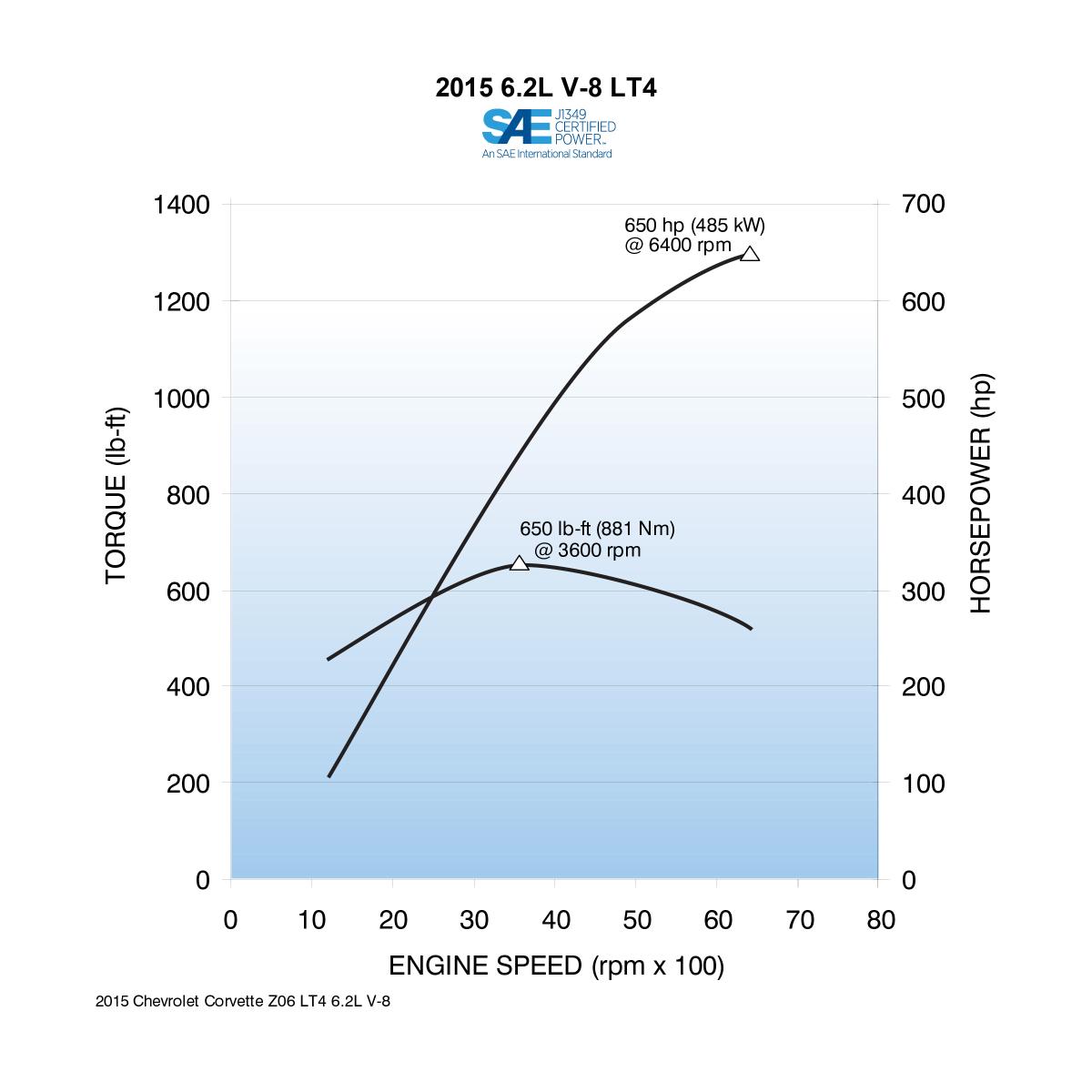
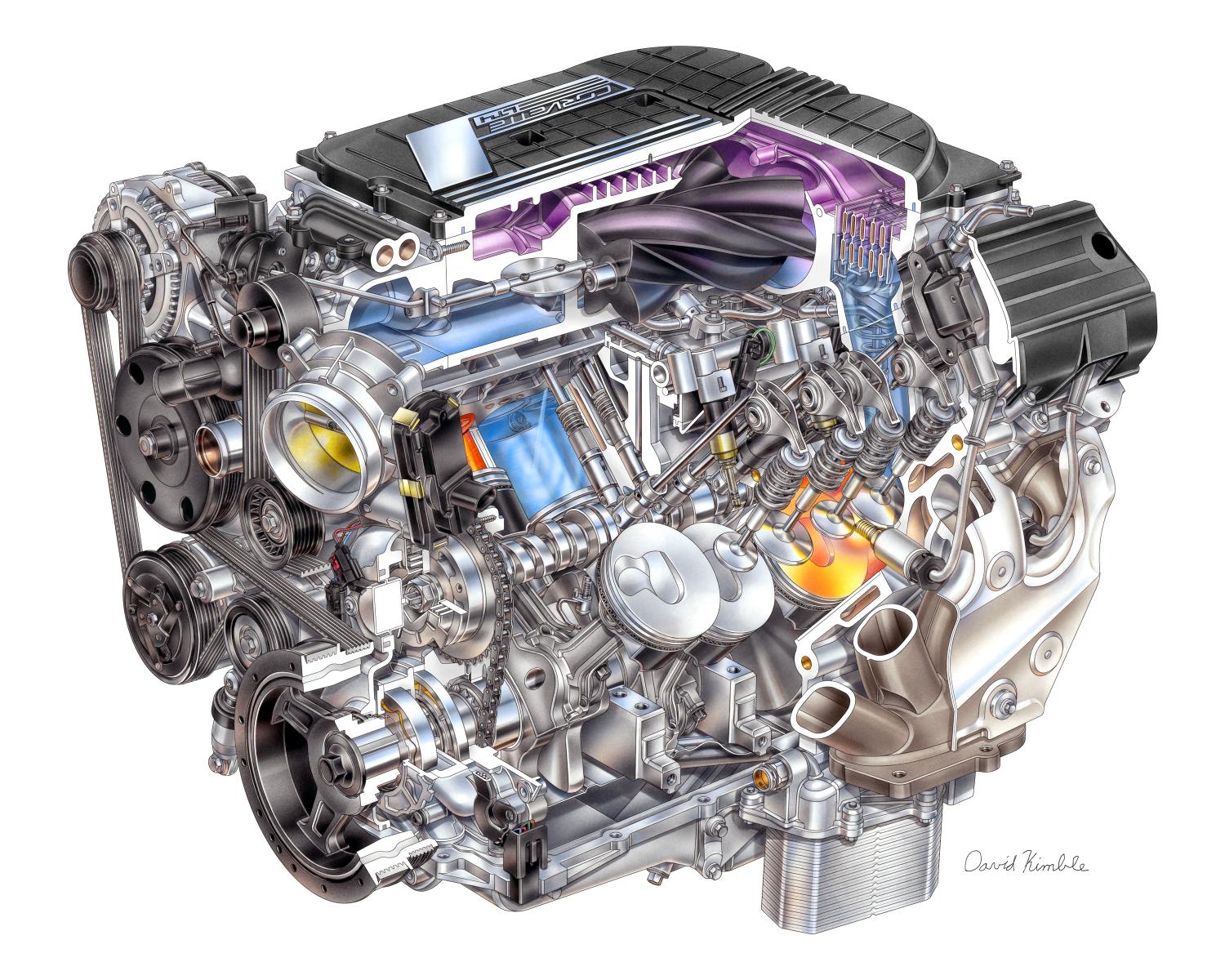

NEW CORVETTE C7.R SHARES TECH WITH NEW Z06
- Co-developed with 2015 Corvette Z06, sharing chassis, engine technologies and aerodynamics strategy
- Makes competition debut Jan. 25 at the 52nd Rolex 24 At Daytona
- Continues legacy of Corvette Racing, which includes 90 global victories and 10 manufacturer championships since 1999
DETROIT – Chevrolet today unveiled the Corvette C7.R race car, which was co-developed with the all-new 2015 Corvette Z06. They represent the closest link in modern times between Corvettes built for racing and the road, sharing unprecedented levels of engineering and components including chassis architecture, engine technologies and aerodynamic strategies.
“When it comes to endurance racing, Corvette has been the benchmark of success for nearly 15 years,” said Jim Campbell, U.S. vice president, Performance Vehicles and Motorsports. “A great deal of the team’s success can be attributed to the symbiotic relationship between Corvette Racing and the production vehicles. The 2015 Corvette Z06 and new C7.R will be more competitive on the street and track due to successful design of the Corvette Stingray – which itself is heavily based on the C6.R race car.”
Corvette Racing will field two C7.R race cars in 2014, starting later this month at the 52nd Rolex 24 At Daytona on Jan. 25-26. The race kicks off the TUDOR United SportsCar Championship – a new series debuting this year after the merger of the American Le Mans Series and GRAND-AM Rolex Sports Car Series. The C7.R will compete in the GT Le Mans class in 11 races around North America.
The team is also is expected to compete in June at the 24 Hours of Le Mans – a race Chevrolet and Corvette Racing have won seven times – in the GTE Pro class.
Since the team’s competitive debut in 1999 with the Corvette C5-R, Corvette Racing has earned unmatched success. The C5-R and C6.R led Chevrolet to 90 victories around the world and 10 manufacturer championships in the American Le Mans Series. In 2013, Corvette Racing won five races and swept the manufacturer, team and driver championships in the GT class for a second consecutive season.
A key part of the team’s success is the technology transfer between Corvette production cars and race cars.
“Corvette Racing sets the gold standard for technology transfer between the track and street,” said Tadge Juechter, Corvette chief engineer. “We are continually taking what we learn in competition, and applying it to improve production Corvettes – which then make better race cars. As a result, the new Corvette Z06 is the most track-capable production Corvette ever while the new C7.R is poised to be even more competitive on the race circuit.”
Many of the architectural and aerodynamic features of the C7.R are based on equivalent components and technologies from the 2015 Corvette Z06, including:
New, aluminum frame
As before, the race car and the Z06 will share the same, production-based aluminum frame. However, for the first time, the frames for the race car and production Z06 will be built in-house at the Corvette’s Bowling Green, Ky., assembly plant.
By leveraging advanced manufacturing materials – such as laser welding, Flowdrill-machined fasteners and a GM-patented aluminum spot-welding process – the production structure is significantly stronger than its predecessor. For Corvette Racing, this equates to a race chassis for the C7.R that is 40 percent stronger than the outgoing C6.R.
“In the first lap in the C7.R, the drivers felt the increase in chassis stiffness,” said Mark Kent, director of Racing for Chevrolet. “The drivers instantly noticed that the C7.R handling was better over changing surface features and rough track segments. This is important as our drivers don’t always stay on the smooth pavement, and are constantly driving over curbing at corner apexes.”
Direct-injected engine
The addition of direct fuel injection to the Corvette Z06 will enable the technology to return to a Corvette race car for the first time since the end of the GT1 era in 2009. It promises greater efficiency, which can make a significant difference in long-distance endurance racing such as Daytona and Le Mans through fewer time-consuming pit stops.
“Direct injection offers two advantages for the race team,” said Kent. “First, it offers drivers more precise throttle control, so that even the smallest changes in the driver’s throttle position delivers a proportional response from the engine. Second, direct injection typically improves fuel economy about 3 percent. That could be enough to bypass one fuel stop during a 24-hour race. Given that races are often won and lost in the pits, a 3 percent gain in fuel economy could translate to a significant advantage in track position.”
Aerodynamics
The aerodynamic strategies of the Corvette Stingray came directly from the Corvette C6.R – including the forward-tilted radiator, functional hood and front-quarter panel vents, and rear transmission and differential cooling intakes.
The Z06 and C7.R take that aerodynamic foundation to the next level, sharing aggressive strategies for increased cooling and aerodynamic downforce, including similar front splitters, rocker panels, and front- and rear-brake cooling ducts.
“We worked concurrently with the race team developing the aerodynamic packages for the Z06 and the C7.R,” said Juechter. “We even used the same modeling software to test both cars, enabling us to share data and wind-tunnel test results. As a result, the aerodynamics of the production Z06 produce the most downforce of any production car GM has ever tested, and we are closing in on the aero performance of a dedicated race car.”
There are, of course, differences between the race car and production Corvette Z06. For example, the C7.R carries over the powertrain for the C6.R, as the GT rules limit the maximum displacement to 5.5L, and prohibit forced induction. By comparison, the new Z06 boasts a supercharged 6.2L engine estimated at 625 horsepower. Both engines, however, are based on the historic small block architecture.
The suspension on the C7.R is modified to accommodate wider racing tires and larger brakes, again part of the GT regulations.
On the aerodynamic side, one major difference is the shift away from U.S. National Advisory Committee for Aeronautics, or NACA, ducts on the C7.R. The C6.R used two NACA ducts, on top of the rear bodywork and near the position of the rear wheels, for cooling. For the new C7.R, there are now openings on each of the rear quarter panels, above the brake ducts, which will draw air to help cool the race car’s transaxle and differential.
Additionally, one of the primary results of the C7.R’s aero detail is making the rear wing a more-significant part of the car’s aero package. A larger radiator inlet has the added benefit of generating smoother airflow over the rear wing and making its use more efficient to the handling and stability of the race car at high speed.

